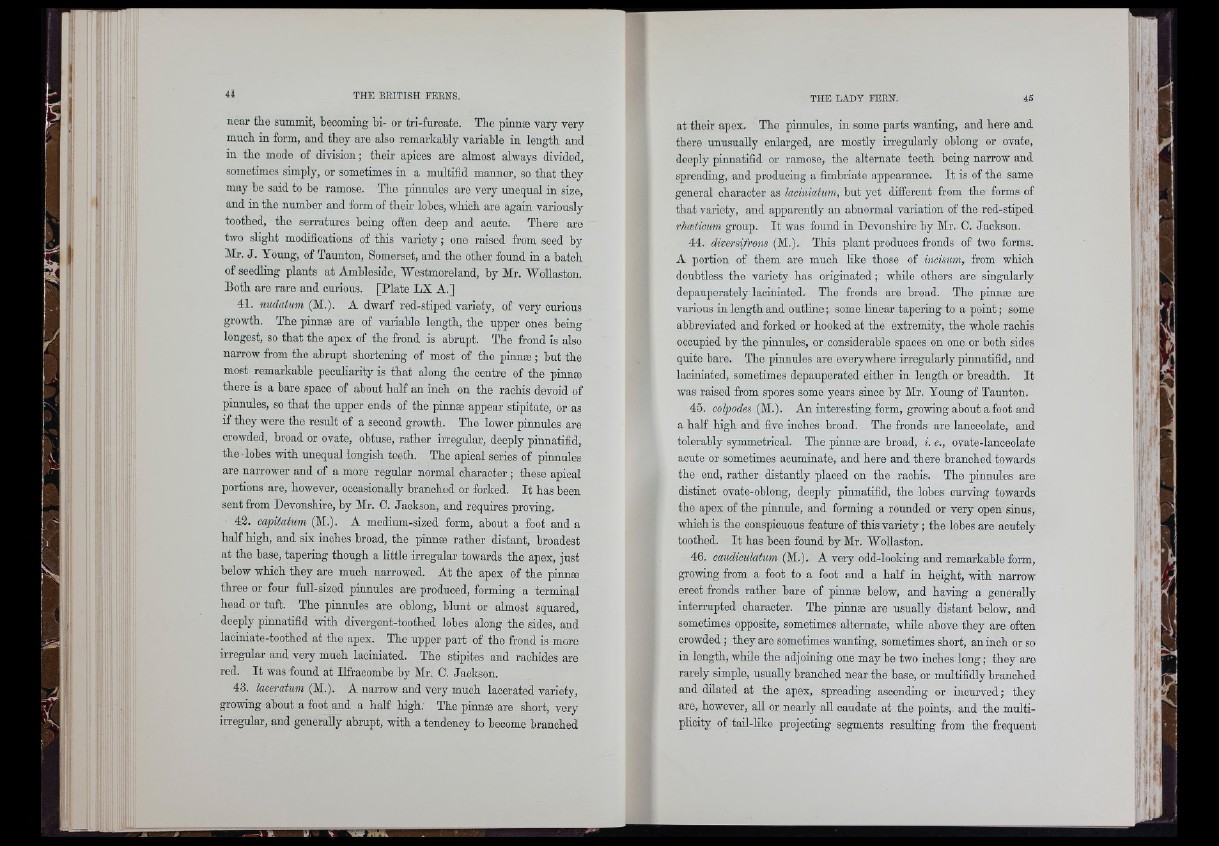
near the summit, becoming bi- or tri-furcate. The pinnæ vary very
much in form, and they are also remarkably variable in length and
in the mode of division; their apices are almost always divided,
sometimes simply, or sometimes in a multifid manner, so that they
may be said to bo ramose. The pinnules are very unequal in size,
and in the number and form of tbeir lobes, which are again variously
toothed, the serratures being often deep and acute. There are
two slight modifications of this variety ; one raised from seed by
Mr. J. Young, of Taunton, Somerset, and the other found in a batch
of seedling plants at Ambleside, Westmoreland, by Mr. Wollaston.
Both are rare and curious. [Plate LX A.]
41. nudatum (M.). A dwarf red-stiped variety, of very curious
growth. The pinnæ are of variable length, the upper ones being
longest, so that the apex of the frond is abrupt. The frond is also
narrow from the abrupt shortening of most of the pinnæ ; hut the
most remarkable peculiarity is that along the centre of the pinnæ
there is a bare space of about half an inch on the raohis devoid of
pinnules, so that the upper ends of the pinnæ appear stipitate, or as
if they were the result of a second growth. The lower pinnules are
crowded, broad or ovate, obtuse, ratber irregular, deeply pinnatifid,
the-lobes with unequal longish teeth. The apical series of pinnules
are narrower and of a more regular normal character ; these apical
portions are, however, occasionally branched or forked. It has been
sent from Devonshire, by Mr. C. Jackson, and requires proving.
42. capitatum (M.). A medium-sized form, about a foot and a
half high, and six inches broad, the pinnæ rather distant, broadest
at the base, tapering though a little irregular towards the apex, just
below which they are much narrowed. At the apex of the pinnæ
three or four full-sized pinnules are produced, forming a terminal
head or tuft. The pinnules are oblong, blunt or almost squared,
deeply pinnatifid with divergent-toothed lobes along the sides, and
laoiniate-toothed at the apex. The upper part of the frond is more
irregular and very much laoiniated. The stipites and rachides are
red. It was found at Ilfracombe by Mr. 0. Jackson.
43. laceratum (M.). A narrow and very much lacerated variety,
growing about a foot and a half high: The pinnæ are short, very
irregular, and generally abrupt, with a tendency to become branched
at their apex. The pinnules, in some parts wanting, and here and
there unusually enlarged, are mostly irregularly oblong or ovate,
deeply pinnatifid or ramose, the alternate teeth being narrow and
spreading, and producing a fimbriate appearance. It is of the same
general character as laciniatum, but yet different from the forms of
that variety, and apparently an abnormal variation of the red-stipod
rhæticum group. It was found in Devonshire by Mr. C. Jackson.
44. diversifrems (M.). This plant produces fronds of two forms.
A portion of them are much like those of incisum, from which
doubtless the variety has originated ; while others are singularly
depauperately laoiniated. The fronds are broad. The pinnæ are
various in length and outline ; some linear tapering to a point ; some
abbreviated and forked or hooked at the extremity, the whole raohis
occupied by tbe pinnules, or considerable spaces on one or both sides
quite bare. Tbe pinnules are everywhere irregularly pinnatifid, and
laoiniated, sometimes depauperated either in length or breadth. It
was raised from spores some years since by Mr. Young of Taunton.
45. colpodes (M.). An interesting form, growing about a foot aud
a half high and five inches broad. The fronds are lanceolate, and
tolerably symmetrical. The pinnæ are broad, L e., ovate-lanceolate
acute or sometimes acuminate, and here and there branched towards
the end, rather distantly placed on the raohis. The pinnules are
distinct ovate-oblong, deeply pinnatifid, tbe lobes curving towards
the apex of the pinnule, and forming a rounded or very open sinus,
which is the conspicuous feature of this variety ; the lobes are acutely
toothed. It has been found by Mr. Wollaston.
46. caudieulatum (M.). A very odd-looking and remarkable form,
growing from a foot to a foot and a half in height, with narrow
erect fronds rather bare of pinnæ below, and having a generally
interrupted character. The pinnæ are usually distant below, and
sometimes opposite, sometimes alternate, while above they are often
crowded ; they are sometimes wanting, sometimes short, an inch or so
in length, while the adjoining one may be two inches long ; they are
rarely simple, usually branched near the base, or multrfidly branched
aud dilated at the apex, spreading ascending or incurved; they
are, however, all or nearly all caudate at the points, and the multiplicity
of taü-like projecting segments resulting from the frequent
- I - I
i' - l
i
I :
■ I . ’ i
('I
J '
•'i
■IM